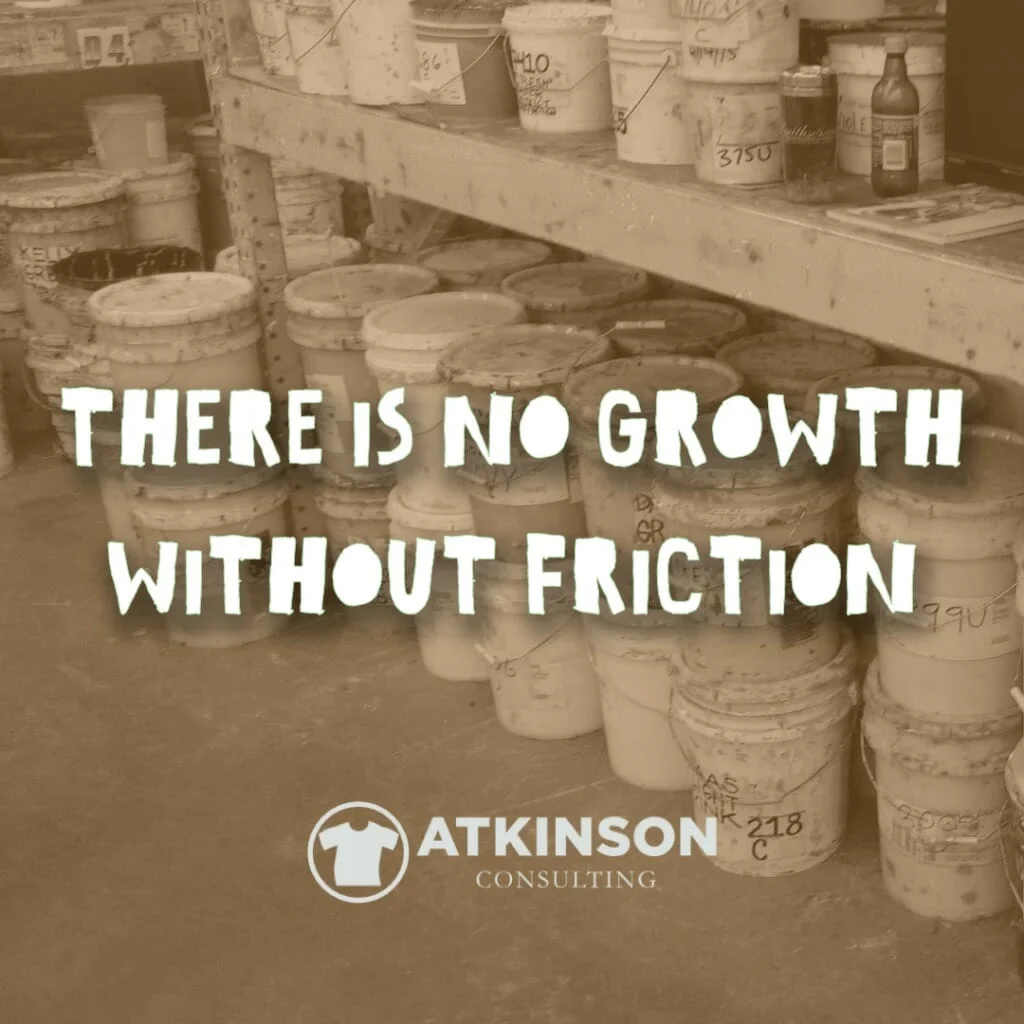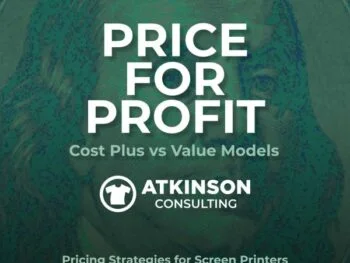Let’s talk about your company trajectory for a minute. You are here. Your goals are over there. The growth you need to bridge that gap? That’s the meat of the sandwich. That’s work.
But here’s the deal. There is no growth without friction.
Nothing is easy.
Things don’t always land in your lap. And you can’t count on luck.
I was speaking with someone the other day about their plans on starting a new company. Let’s call her Susie. (Not her real name) She was asking me questions about equipment, processes, and software.
I asked two questions before we dug into the conversation.
“Have you written a business plan?”
“Who are your customers?”
Susie didn’t have an answer for either. “Kinda, sorta…”, isn’t a strategy.
Part of understanding how to succeed in business is defining your journey. How is your Brand going to be different than all the other yahoos out there?
Friction Comes Before Growth
It is the friction part of the growth that people avoid.
About 60%-70% of the shops I talk to have never written a business plan. Because it’s work. It takes time. It involves answering uncomfortable questions.
The cost of entry into this industry isn’t much. Just about anyone that can fog a mirror can get into this game.
Because they don’t possess much skill, experience, creativity, or relative value the first thing they do is drop their pants on prices.
Free this, free that…I’ll be a nickel cheaper than you.
We’ll fire as many missiles we can at any target on the horizon in hopes that something goes boom.
Ready. Fire. Aim.
Plenty of folks in your customer pool are duped into doing business with that guy. And frankly, it’s the pain the butt customers that usually are jumping that way.
Oops. I didn’t just describe your shop by mistake did I?
Creating long-term sustained growth is harder because it takes strategy. Aligning what you do with what your customers crave can be difficult.
Uncomfortable even. In that uncomfortableness is the friction that is linked to the growth you seek.
Susie told me, “Oh sure, I can write a business plan. That’s easy. What I need to know is what shirts I should be buying for my customers.”
Say what? If you don’t know who your customers are, how can you decide what they might like?
Eliminate the friction and do the work. Everyone wants to start at the top. That rarely ever happens.
Overnight success takes ten years of work.
Aim Small – Hit Small
I’ve been working lately with many of my coaching clients on their price lists. Part of that conversation involves discussing the average quantity of orders.
Do you know yours?
For real. Have you completed the actual math, or are you guessing?
Do the math.
The reason this is important is that the average size of the orders has a lot to do with the productivity and efficiency you turn in daily. Smaller order averages produce a lot of downtime. Longer runs in production can drive more cost savings and economies of scale..
Remember, you are only making money when you are decorating a shirt.
Lowering the cost per impression is tied to the size of the orders and the efficiency of the shop.
So one question that should be relevant to your growth is:
“How are you marketing your company?”
Are your campaigns focused on potential customers with larger order sizes? Is the reason your shop seems to get a lot of smaller jobs is because you haven’t built the sales engine to obtain larger ones?
Aim small hit small. Aim big hit big.
Refine Your Conversations
Before you start your next conversation with a customer regarding their order, ask “How are you going to be using the shirts”?
Get away from immediately talking about price. Or even a shirt brand for that matter.
Spin the conversation towards their mindset on their shirts. Do they want the shirt to be worn more than once? Should it be a favorite in their closet? How are these shirts being used by the end consumer?
This is a more difficult conversation. (Friction again)
But it is a great one to have as it focuses on creatively solving their problem. It’s how you generate art ideas that work with the apparel choice.
Everything that you decorate doesn’t have to be on the most inexpensive blank available. Quit quoting the same cheap-ass shirt all the time.
Not to mention when your dialog is about the perceived value of the garment to their customer, that’s when you can talk about extras. Branding their logo with a custom neck, woven hem or sleeve label, hangtagging, polybagging, and even packaging for the shirt.
Upgrade the art with more colors. Maybe a different technique or image location.
Discuss the experience of receiving the shirt. Is it tossed at someone like a string of Mardi Gras beads?
Or, should there be a magic moment when they open the box and angels sing Hallelujah?
Consultative selling is a proven way to increase growth and remove friction from the buying experience. You aren’t selling them something, you are advising on the best path to take to solve their challenge.
Get away from just hawking ink on cotton. Discuss value instead.
Grow Your Current Customers
The best customer to have is the one you already own. Let’s wrap up this article with some thoughts on customer retention.
What part of your marketing strategy do you have that squarely addresses this position?
If you are like most shops you simply act as an order taker. Like a waitress in a diner, “You want some pie with that coffee?”
Very little effort is made with an on-going effort to keep the stable of customers you currently have happy, or for that matter, grow their business.
That’s the friction point.
Think of it this way. They already like you. You are half-way home with a new sale. Are you waiting for them to come to you, or do you have a plan to bring the discussion points to them?
They aren’t thinking about your shop or they don’t know everything you can do. There are simply too many customization choices that shops can produce. It is hard to talk about everything at once.
Show and Tell
Which is why you need a “Show and Tell” strategy.
If you haven’t already, sign up for a MailChimp account.
It’s free for the first 2000 customers you import into your account’s database. For the majority of shops out there, that means everyone you’ve ever done business within your entire history. If you have more, that’s great too. Pick the top ones that matter.
Next, create some campaigns showing off what you can do. That’s right. Show off!
“Check out this great embroidery piece we just shipped!”
“Did you know we can do baseball cap + t-shirt bundles?”
“Let us do a brand makeover with your logo!”
“Survey: Which do you like better – Branded Water Bottles or Stainless Steel Tumblers?”
The great thing about these posts is that they can be created in advance. You can add a call to action to increase sales. Links to your website or portfolio page are easy to throw in.
Another great tip is that as you add new customers to the list, they can start getting automatically scheduled posts like the ones mentioned above.
You don’t have to remember to do anything. It is automated marketing. For those of you out there that are always complaining that you “don’t have time to do any marketing”, this works.
Action = Growth
Get off your butt and set it up.
Again, it is the friction point for growth. You have to organize and plan. Build the outgoing pieces. Do the work.
MailChimp isn’t going to come knocking on your door begging for you to work with them. So instead of constantly looking outward for new people to talk to for sales, spend some quality time with the customers that are already spending money with you.
Make them feel special.
“Vision without action is a daydream. Action without vision is a nightmare.” – Japanese proverb
“Without continual growth and progress, such words as improvement, achievement, and success have no meaning.” – Benjamin Franklin
“A gem cannot be polished without friction, nor a man perfected without trials.” – Lucius Annaeus Seneca
Speaking of Business Plans…
“Shop Basic Info Pack”

This eBook was written for shops just like yours. But it isn’t just a normal book.
It contains fully customizable templates for you to create a Business Plan, and a robust Employee Handbook.
There is a great section on Branding for your shop.
Plus for the production minded a customizable screen-print Production Log and Dashboard system that you can use to analyze your shop’s production. Get that data you need to interpret what’s going on on your production floor.
Did you like this article? Subscribe!
[mc4wp_form id=”16634″]





2 comments